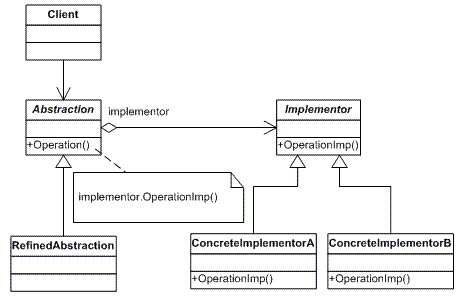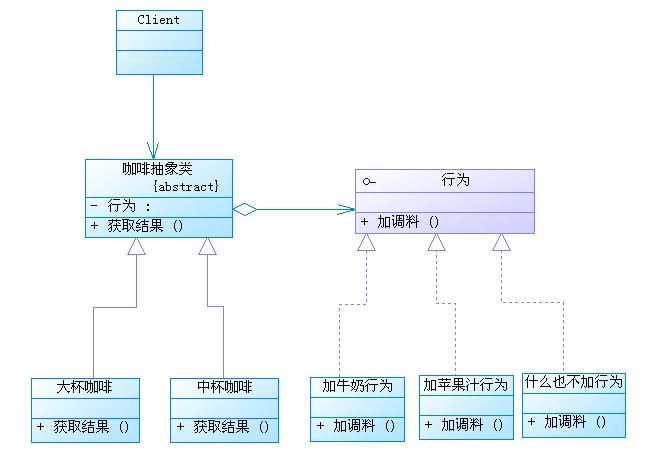桥接模式
关于桥接模式的定义:
将抽象与行为相分离,使得他们各自可以独立变化,然后可通过动态组合得到想要的结果,目标是实现解耦。桥接模式的类关系图如下:

现在举一个例子来说明桥接模式.
以最常用的咖啡问题来说明。现在模拟的场景是这样子的:
| 咖啡有分大杯和中杯,同时咖啡里面可以选择加牛奶,也可以选择加苹果汁,也可以什么都不加。因为刚开张,所以目前就只有大杯和中杯,未来可能会有更多规格的杯子,同时也会有更多的调料给客人选择,设计一个具有弹性的程序 |
分析:按照目前的情况,最简单的做法就是分别写出6种类,来表示六种不同组合的咖啡。
我们可以分析到这种做法虽然和直观,但是会存在很多问题,其中之一就是这6个类的每一个类都已经具体的代表了一种咖啡,换句话说,这几个类是没办法复用的,这当然是我们不想要的,另外一个问题就是,如果添加一个规格的杯子,比如小杯,又要再写小杯中分别加不同调料的类,可想而知,后面店的规模大起来的话,会造成类的“炸弹”。
我们想要的结果是,当增加一种调料时只需要增加一个类,增加一个杯子规模的时候也只需要增加一个类就可以达到目的,这就需要用到桥接模式了。
桥接模式分析法:把属性和行为分别抽象并独立开来,行为就是加牛奶加苹果汁等,属性就是大杯中杯之类的。我们的目的就是把行为和属性完全没有耦合,通过组合来形成不同的咖啡,通俗点说,例如我们只提供的各种零件,让使用者去使用而已,不提供整合好的东西。
请看分析的类图:

具体来看看代码的实现:
/**
* 咖啡的行为
* @author ChenST
*
*/
public interface Action {
/**
* 做事情
* @return
*/
public String doThing();
}
/**
* 加牛奶的行为
* @author ChenST
*/
public class AddMilkAction implements Action {
@Override
public String doThing() {
return "加了[牛奶]";
}
}
/**
* 什么也不加的行为
* @author ChenST
*/
public class EmptyAction implements Action {
@Override
public String doThing() {
return "什么也没加";
}
}
/**
* 加了苹果汁
* @author ChenST
*
*/
public class AddAppleAction implements Action {
@Override
public String doThing() {
return "加了[苹果汁]";
}
}
/**
* 咖啡抽象类
* @author ChenST
*/
public abstract class Coffee {
private Action action;
public Coffee(Action action){
this.action = action;
System.out.println(this.result());
}
public Action getAction(){
return action;
}
/**
* 得到的咖啡结果
* @return
*/
public abstract String result();
}
/**
* 大杯咖啡
* @author ChenST
*/
public class BigCupCoffe extends Coffee {
public BigCupCoffe(Action action){
super(action);
}
@Override
public String result() {
String thing = this.getAction().doThing();
return "[大杯]"+thing+"的咖啡";
}
}
/**
* 中杯咖啡
* @author ChenST
*
*/
public class MiddleCupCoffee extends Coffee {
public MiddleCupCoffee(Action action){
super(action);
}
@Override
public String result() {
String thing = this.getAction().doThing();
return "[中杯]"+thing+"的咖啡";
}
}
public class Test {
public static void main(String[] args) {
//加牛奶的大杯咖啡
Coffee coffee1 = new BigCupCoffe(new AddMilkAction());
//什么也没加的大杯咖啡
Coffee coffee2 = new BigCupCoffe(new EmptyAction());
//加苹果汁的大杯咖啡
Coffee coffee3 = new BigCupCoffe(new AddAppleAction());
//加牛奶的中杯咖啡
Coffee coffee4 = new MiddleCupCoffee(new AddMilkAction());
//什么也没加的中杯咖啡
Coffee coffee5 = new MiddleCupCoffee(new EmptyAction());
//加苹果汁的中杯咖啡
Coffee coffee6 = new MiddleCupCoffee(new AddAppleAction());
}
}
[大杯]加了[牛奶]的咖啡 [大杯]什么也没加的咖啡 [大杯]加了[苹果汁]的咖啡 [中杯]加了[牛奶]的咖啡 [中杯]什么也没加的咖啡 [中杯]加了[苹果汁]的咖啡
2022年9月01日 05:51
Government of the People’s Republic of Bangladesh, Directorate of Primary Education (DPE), is going to announce PSC Result 2022 in student wide on 30th December 2022 for all divisional Grade 5 exam result with Ebtedayee Result 2022 for annual final terminal examinations, The Primary School Certificate Examination Result 2022 will be announced for both of General and Madhrsah students in division wise to all education board known as Prathomik Somaponi Result 2022. Rajshahi Board PSC Result Full MarksheetThe DPE has successfully conducted the class 5th grade PSC and Ebtedayee Examination tests from 17th to 24th November 2022 under all education boards of Dhaka, Chittagong, Comilla, Rajshahi, Sylhet, Barisal, Jessore, Dinajpur and Madrasah Board, and the DPE Grade-5 exams are successfully conducted at all 7,194 centers across the country.